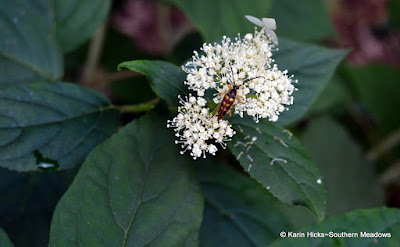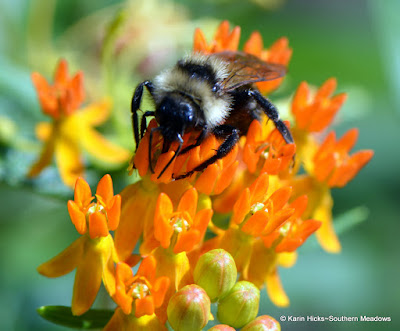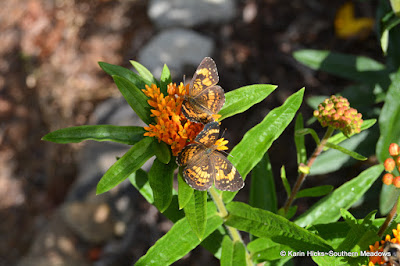Summer is peak insect season and as a habitat gardener, observing how the pollinators use our garden is important in gaining insight into how well the native plants are working in our ecosystem. Part of this process is documenting which blooms are being visited by pollinators over the course of the day/month/season.
While some plants have a special relationship with one pollinator, other plants are very popular with a wide variety of insects. Last summer, I highlighted a few of the plants that attract many beneficial pollinators to our garden, including devil's walking stick (Aralia spinosa), buttonbush (Cephalanthus occidentalis) and rattlesnake master (Eryngium yuccifolium). (Read:
Not All Plants Are Created Equally ) Here are a few more plants that are invaluable to pollinators in our garden.
Not all plants that attract pollinators grow in the sun
. Smooth hydrangea (Hydrangea arborescens) is a key nectar source in the shadier parts of our garden. Blooms are covered with several species of bees and beetles, who dine amicably on this open buffet. Bumblebees maneuver themselves around the creamy white flowers so rapidly it's difficult to capture a decent photo.
Swallowtail butterflies are constant visitors, morning to dusk, to the summer blooming
bottlebrush buckeye (Aesculus parviflora) flowers. Another shade loving shrub, this is one of three species growing in our garden. Others include red buckeye (Aesculus pavia), one of the best plants at attracting hummingbirds and one of the first red tubular shaped flowers of the season, and painted buckeye (Aesculus sylvatica), also an early spring bloomer with white tubular blooms.
Bottlebrush buckeye also attracts bumblebees, wasps and hummingbirds. Bees and wasps hang onto the wand-like panicles to reach into the trumpet to retrieve nectar.
Watching the insects moving around the flower as they dangle and swing through the inflorescence is like watching 'American Ninja Warrior' competition for pollinators.
 |
| blue mud dauber |
|
Narrow-leaved mountain mint (Pycnanthemum tenuifolium) flowers are alive with dancing pollinators. A spectacular variety of bees, butterflies, wasps and moths call on the showy blooms that have a long bloom period throughout the summer.
 |
| Variegated fritillary butterfly and bumblebee |
 |
| Variegated fritillary and Pearl Crescent butterflies |
 |
| Bumblebee hugging mountain mint bloom |
 |
| Pearl Crescent butterfly |
Butterfly weed (
Asclepias tuberosa), a popular milkweed choice, is an ecosystem unto itself. I've written about this milkweed previously (
Read: Got Milkweed) but would be remiss if I didn't include it here because it is covered with bees and butterflies throughout the summer season.
Monarchs butterflies usually visit our garden during their Spring and Fall migration, but milkweed blooms provide nectar to other pollinators during the summer months and also serve as a host plant for the milkweed tussock moth and food source for milkweed bugs.
With more homeowners wanting to support monarchs the demand for milkweed plants has increased dramatically, hence more and more nurseries have it available. This is good news for the monarchs and other beneficial pollinators; however, it is important to know if the plants you are purchasing have been pre-treated with
neonicotinoids, a systemic chemical that is distributed through all parts of the plant including the pollen and nectar. The intention is to prevent infestation of sucking and chewing 'pests' such as white flies, emerald ash borer, and Japanese beetles, but it is also detrimental to important pollinators who visit the plant's blooms seeking nectar. If you grow treated plants in your garden you will be doing more harm than good to the pollinator populations.
So, where is the pollinator party in your garden? Have you ever considered observing the diversity of pollinators that visit the plants in your garden? Try comparing native plants versus ornamental plants or straight species versus hybrids and discover what are the hardest working plants in your garden. Then plant more of them!
















.png)
